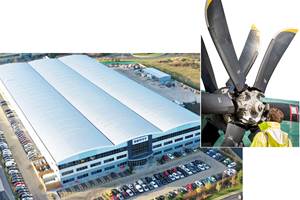Carbon fiber composites: Into the automotive mainstream?
Altair Engineering Inc.'s (Troy, Mich.) VP of aerospace solutions Robert Yancey asks if automakers will follow aeromanufacturers in embracing carbon fiber.
The use of composites continues to grow, and all forecasts show that the composite materials industry will grow at a faster rate than most industries during the next decade. Although the aerospace and wind-energy industries dominate usage today, many forecasters see large growth potential in automotive. Given the volumes of material used by the auto industry, any significant use of composites in mainstream automobiles will lead to a large increase in the composite materials market. In fact, the market in automotive could easily outstrip the aerospace market in a very short time.
In the auto industry, the use of carbon composites, to date, has been limited to racecars, high-end performance vehicles and some high-end luxury vehicles. The higher cost of these materials is more easily justified in high-end vehicles, and the performance advantages justify their use in racecars. Driving their potential use in mainstream automobiles are much more stringent fuel economy standards in the U.S. and new tail-pipe emissions standards in Europe.
Although there are a number of design modifications that can improve engine efficiency, structural weight reduction can accomplish this goal, and it has a multiplier effect on fuel economy. For example, if you reduce the weight of an automobile structure, you can achieve acceptable performance with a four-cylinder, rather than a six-cylinder, engine. This not only reduces fuel consumption, it also reduces engine weight, which leads to even greater fuel economy.
One trend that points to the auto industry’s interest in carbon composites is the succession of auto OEM/fiber supplier partnerships formed over the past few years. BMW and SGL partnered to build a carbon fiber production plant in the U.S., which will supply material for the BMW i3 and i8. Since then, General Motors and Teijin have teamed up; Toyota, Toray and Fuji Heavy Industries have joined forces; Ford and Dow are working together; and Aston Martin, Delta Motorsport, Pentangle Engineering Services and Cytec (formerly Umeco) are cooperating.
These partnerships are promising, but they are no guarantee that composites will be used in mainstream passenger vehicles in the near future. All it means is that an increased use of composites is one option automotive OEMs are investigating to keep up with evolving fuel economy standards.
There are a number of roadblocks that have the potential to halt these efforts. One is the perennially high cost of composites compared to metals. Another is uncertainty about fiber supply. Because the capital costs of fiber production are very high, carbon fiber producers are unwilling to invest in new capacity without firm data on future demand. The aerospace industry can make long-term commitments for fiber because their order backlogs are measured in years. Auto OEMs don’t have that luxury. A third roadblock is that many structural auto applications don’t require the mechanical properties of carbon composites, so the motivation for using them is perceived as mere weight reduction. There are multiple ways to reduce the weight of nonstructural parts, and many are less expensive. There are other auto applications where the material properties of a composite can be a negative factor, so that also presents a challenge. For example, high-stiffness composites are not well-suited for crash crumple zones that are designed to absorb impact energy in a controlled manner. Last, metal suppliers are aggressively working to preserve market share by developing materials that weigh less and perform better.
Aerospace and automotive OEMs alike need strong, lightweight materials that can perform in harsh environments and benefit from the corrosion and fatigue resistance of advanced composites. Both industries must address recycling and repair issues with these materials. But the industries also differ. The aerospace industry has some requirements that do not pertain to automotive applications, such as structural certification and buckling stability. And the auto industry has unique limiting factors beyond high material cost, including surface finish and impact performance requirements, manufacturing cycle time, joining, manufacturing infrastructure and volume.
Fortunately, the auto industry can benefit from the knowledge and experience that aerospace OEMs have gained over the past few decades as it moves forward with composites. Likewise, the knowledge and expertise that the auto industry will gain as it addresses its unique challenges will make it back to the aerospace industry. There is truly a symbiotic relationship between the two industries and, in the end, the consumer will be the ultimate beneficiary.
Related Content
Materials & Processes: Composites fibers and resins
Compared to legacy materials like steel, aluminum, iron and titanium, composites are still coming of age, and only just now are being better understood by design and manufacturing engineers. However, composites’ physical properties — combined with unbeatable light weight — make them undeniably attractive.
Read MoreWhy aren't composites synonymous with infrastructure?
The U.S. seems poised to invest heavily in infrastructure. Can the composites industry rise to the occasion?
Read MorePlant tour: Dowty Propellers, Gloucester, U.K.
Transforming decades of design and RTM production reliability into more sustainable, next-generation composite propellers.
Read MoreNatural fiber composites: Growing to fit sustainability needs
Led by global and industry-wide sustainability goals, commercial interest in flax and hemp fiber-reinforced composites grows into higher-performance, higher-volume applications.
Read MoreRead Next
From the CW Archives: The tale of the thermoplastic cryotank
In 2006, guest columnist Bob Hartunian related the story of his efforts two decades prior, while at McDonnell Douglas, to develop a thermoplastic composite crytank for hydrogen storage. He learned a lot of lessons.
Read MoreComposites end markets: Energy (2024)
Composites are used widely in oil/gas, wind and other renewable energy applications. Despite market challenges, growth potential and innovation for composites continue.
Read MoreCW’s 2024 Top Shops survey offers new approach to benchmarking
Respondents that complete the survey by April 30, 2024, have the chance to be recognized as an honoree.
Read More














.jpg;maxWidth=300;quality=90)







